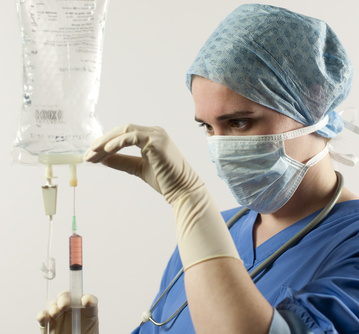IV Infusion Calculations
This page discusses IV Infusion Calculations which are used by Pharmacy Technicians in different settings, including IV Compounding Techs.
Everyone who has ever been in a hospital, worked inside a hospital or known someone who has been treated there has been exposed to intravenous therapy at some time or another.
It all looks remarkably complicated doesn't it? The reality is that the medications can be life-giving, or life threatening, depending on how good we are at our jobs.
Making sure that the IV Infusion Calculations (which afford our patients their chance to get well) are perfect is your job. Making sure that those medications are delivered safely and in the right way is also our job and it's a task that is absolutely critical and can cost someone their good health when it comes right down to it.
Not to put pressure on anyone, but merely to state what you already know--knowing your calculations and the simple math that it takes to arrive at the right dosages is imperative and it's something that isn't difficult, but does take concentration and close attention to detail.
For everyone who is termed as medical personnel, from pharmacy technician upward to pharmacist, nurse, paramedic and nursing staff, it is imperative that they understand IV Infusion Calculations, IV mixtures, IV dosages and rate of flow of intravenous medications.
Knowing how to calculate the dosages and the flow rate is imperative for anyone who will be involved with medicating a patient or client in any way.
IV, which stands for intravenous, pertains to anything which is directly injected into the veins of a patient.
In the very recent past, intravenous pumps needed to be calculated by hand. While many are not computerized, it's necessary to know how to compute the dosages and to regulate the rate of flow manually no matter how your iv pumps operate.

IV Infusion Calculations involve several different sets of information.
Intravenous calculations are set to drops per milliliter, or gtt/ml. There are also drops per min. Drops per minute are adjusted on the intravenous pump and should never be confused with drops per ml.
Intravenous infusion devices or pumps are set to deliver so many drops per milliliter. This is known as the drop factor. It tells you how many drops of fluid are delivered per milliliter of fluid.
To arrive at the answer for how many milliliters or drops you want to deliver you'll use a very basic formula:
(Volume or Milliliter) (Drop Factor) (Flow)
Rate
Minutes x gtt/Ml = gtt/min

One IV Infusion Calculation example appearing online multiple times is this one:
Mrs Harding has a prescription for 720 milliliters of mixture which must be administered over a six hour time span.
In order to attain that precise administration, how would you figure out the per hour and per minute rate?
720 milliliters divided by 6 hours gives you 120 milliliters necessary per hour
To determine then how much must be administered every minute, you'd use this formula:
120 ml/hour divided by 60 (the number of minutes in an hour)
You'd arrive at an answer of 2 milliliters per minute which must be infused in order to achieve the amount of fluid that you need to infuse in the six hour time span.
If your infusion device or pump delivers 10 drops per milliliter then you'll need to deliver enough drops to infuse the two milliliters per minute.
To arrive at the right amount per minute, your drop factor has to be calculated.
In order to do that, you'd take the 2 milliliters per minute that you need and multiply that by the number of drops your pump delivers in a milliliter.
In other words, for this calculation, you'd be using this formula
2/ml/min x 10 gtt per milliliter = 20 drops per minute that have to be delivered.
If it seems too easy when displayed this way, trust us, it really is that easy.
It can, of course, get a lot more complex when you're looking at fractions, decimal points,
drop rounding and rounding down, but so long as you don't confuse the
drops per minute with the drops per milliliter, the fact is that
IV infusion calculations are nothing more than simple math: adding,
subtracting, multiplication and division.
Of course not every medication is delivered in Milliliters.
Some are delivered in micrograms or mcg, while others are delivered in other dosages.
Finding the proportions and converting them are all that's necessary.
For
example, if you're administering a medication that requires the patient
to receive 5 micrograms per minute and the pharmacist has sent you an
IV container that is contains 50 ml of fluid with 25 mcg of the
medication added, what rate (of milliliters per minute) would the IV require?
Bear in mind that the fluid is nothing more than a "vehicle" for the medication.
It
is the amount of medication that is in the fluid that we want to
deliver correctly, but the fluid has to be taken into account as well.
It seems a bit more confusing but really isn't.
We know that the fluid is 50 milliliters. We know that 25 mcg of the medication is in there.
That means that for every 2 milliliters of fluid, your patient will get 1 mcg of medication.
So, in this example, we are wanting 5 mcg / minute. At 50 ml / 25 mcg, which equals 2 ml / 1 mcg, we would need to multiply by 5 mcg...
(5 mcg / minute) X (2 ml / 1 mcg) = 10 milliliters(/5 mcg) / minute
That's an easy one, but what if they delivered the medication so that
rather than 25 mcg was in there. you were told that in the 250
Milliliters of fluid there were 25 milligrams in the fluid.
If you still needed to deliver that 5 mcg per minute according to the doctors orders, then how would we find that?
The answer again is simple math. We need to convert the mg to mcg.
In order to accomplish that we'd break it down:
The metric system is based on tens, hundreds and thousands.
1 milligram = 1000 micrograms
Plug this into your question:
25 MG---->25,000 mcg------->=5 mcg / minute (desired rate)
Convert Milligrams to Micrograms:
25mg (X1000) = 25,000 mcg
From there, to get to 5 mcg, we divide by 5000 mcg.
25,000 mcg / 5,000 mcg = the 5 mcg (that we want)
So, keeping with the same ratio on each side of the equation, we divide 250 ml by 5000...
250 ml / 5000 mcg = .05 ml / 5 mcg / minute
Bear in mind that you will be called upon to know if that dosage is inaccurate or if it seems out of place for you.
Your role as a pharmacy technician will also be to ensure that if you see something that doesn't seem right, it is your responsibility to question it. You should ensure the safety of your patient through checking your own work and thoroughly checking the IV Infusion Calculations that have been made by your coworkers.
With a little math practice and a little care and attention to detail, your future as a pharmacy technician will be satisfying and enjoyable.
Top of IV Infusion Calculations










New! Comments
Have your say about what you just read! Leave me a comment in the box below.